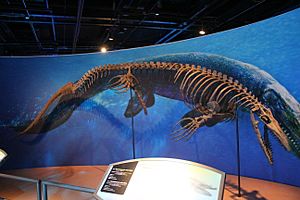Taniwhasaurus facts for kids
Quick facts for kids Taniwhasaurus |
|
|---|---|
 |
|
| Reconstructed skeleton of T. antarcticus, Field Museum | |
| Scientific classification |
|
| Kingdom: | Animalia |
| Phylum: | Chordata |
| Class: | Reptilia |
| Order: | Squamata |
| Superfamily: | †Mosasauroidea |
| Family: | †Mosasauridae |
| Subfamily: | †Tylosaurinae |
| Genus: | †Taniwhasaurus Hector, 1874 |
| Type species | |
| †Taniwhasaurus oweni Hector, 1874
|
|
| Other species | |
|
|
| Synonyms | |
|
|
Taniwhasaurus (say: Tan-ee-wah-SAWR-us) was a large, meat-eating marine reptile that lived long ago. Its name comes from the Māori word taniwha, which means a supernatural water creature, and the Greek word for lizard.
This amazing creature was a type of mosasaur. Mosasaurs were powerful swimming lizards that ruled the oceans during the Cretaceous Period. Taniwhasaurus was a close relative of another mosasaur called Tylosaurus.
Fossils of Taniwhasaurus have been found in different parts of the world. These include New Zealand, South Africa, Japan, and Antarctica. This shows that these ancient marine reptiles lived across many oceans!
Contents
Meet the Taniwhasaurus Species
Scientists have identified a few different species of Taniwhasaurus. Each one was found in a different place.
The New Zealand Taniwhasaurus: T. oweni
Taniwhasaurus oweni is the main species that gives the whole group its name. It was first found and described in 1874 by a scientist named James Hector. The fossils were discovered in New Zealand, in rocks from the late Campanian age. This means they are about 72 to 83 million years old!
The first fossils found included parts of a skull, backbones (vertebrae), and bones from its paddles. These parts were found separately but were believed to belong to the same animal. More skull and backbone pieces were found in 1999.
The South African Taniwhasaurus: T. capensis
Another species, Tylosaurus capensis, was described in 1912 from fossils found in South Africa. These fossils were from an older time, the Santonian age. They included small pieces of a jaw bone and one backbone.
Later, in 2019, scientists looked at these fossils again. They realized the bones looked more like Taniwhasaurus than Tylosaurus. Because the fossils were not complete, it was hard to be sure. But they decided to move this species into the Taniwhasaurus group.
The Antarctic Taniwhasaurus: T. antarcticus
In 2002, a new mosasaur was found on James Ross Island in Antarctica. It was first named Lakumasaurus. However, when scientists studied the fossils again in 2007, they found something interesting. They realized that Lakumasaurus was actually the same as Taniwhasaurus.
So, the species was renamed Taniwhasaurus antarcticus. This shows how scientists learn more over time and sometimes change names as they understand fossils better.
The Japanese Taniwhasaurus: T. mikasaensis
For a while, there was a mystery marine reptile from Japan called "Yezosaurus." People first thought it might be a Tyrannosaur dinosaur! But later, it was identified as a mosasaur or ichthyosaur.
In 2008, scientists officially described this animal as Taniwhasaurus mikasaensis. However, some scientists believe there isn't enough fossil evidence to say for sure if T. mikasaensis is truly different from T. oweni. So, it's still a bit of a puzzle!
See also
 In Spanish: Taniwhasaurus para niños
In Spanish: Taniwhasaurus para niños



